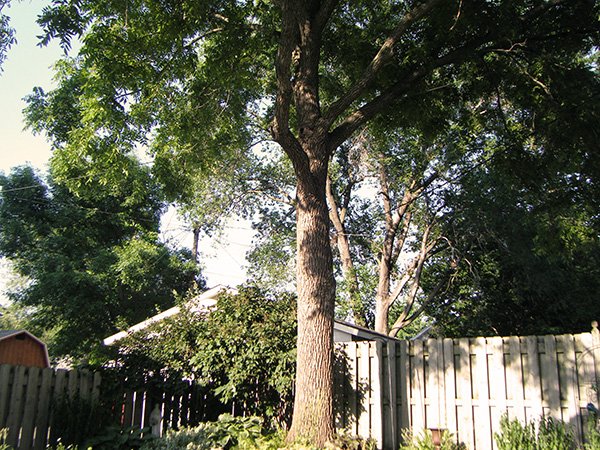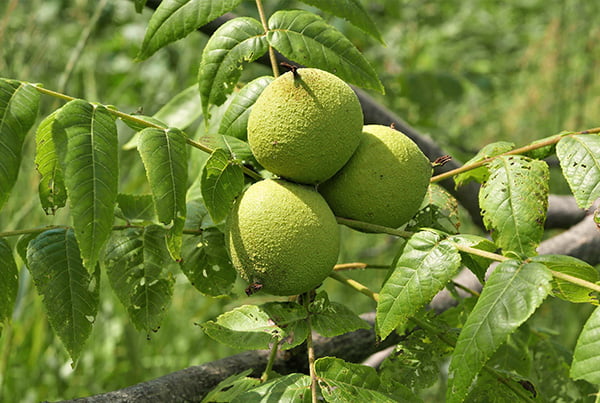Black walnuts are beautiful trees and highly valuable wood-producing trees in North America. They produce a fantastic, closed-grain black walnut wood that can turn into beautiful cutting boards, mallets, bowls, spoons, and arts. And the walnuts themselves are both edible and nutritious!
So, should you plant one yourself? Read on to learn all about black walnut trees, the toxic compound they produce, and where's the best place to grow one!
Botanical Name
Common Name
Plant Type
Mature Size
Sun Requirement
Soil Type
Hardiness Zone
Pet Friendly
Juglans nigra
Eastern Black Walnut Tree, American Walnut
Deciduous Tree
80-130' Tall
Full Sun
Clay, Sand, Or Loam, Well Drained Soil
4-10 USDA
No
What Are Black Walnut Trees?
The black walnut tree (Juglans nigra) is a quick-growing shade tree, adding a full 1 to 3 feet to its height each year! They typically top out between 80 and 130 feet. If spaced out appropriately and allowed to grow freely, it will branch out to 50 feet because of a very shapely tree. The main trunk is long and does not branch out until the upper half of the tree, making the trunk prized for its lumber.
Black walnuts are typically the first tree species to change color in the fall, with their large, compound leaves turning into a brilliant yellow. And these leaves are truly large! Each leaf compound reaches 18 inches in length. The individual leaves are narrow and have a smooth leaf surface and a slightly serrated edge.
Black Walnut Flowers And Fruit
Once a black walnut tree is about five years of age, it will start to bloom. For about two weeks in the spring, black walnut trees will flower. Each tree produces both male and female flowers, so the tree is self-pollinating. The male flowers are attached to stems that hang down about 5 inches, and the female flowers are found on the ground on a small spike.
The female blooms, when pollinated, grow to produce the trademark black walnut fruit. Each floret will turn into a golf ball-sized nut. These nuts will initially have a thick green outer husk. As the nut matures, the husk will turn yellow, light brown, and black. The husk will shrivel as well, resulting in a mature nut that is black, shriveled, and about the size of a ping pong ball.
Squirrels and other rodents will happily take care of all of these nuts. However, a mature black walnut tree produces many, many of these delectable nuts. Dealing with these nuts in rain gutters or while mowing can cause hardship.

Image Source: Flickr
Juglone And Black Walnut Toxicity
Black walnut trees produce juglone in their roots, and other members of the walnut family contain it too. This juglone, while beneficial to the black walnut itself in many ways, can harm and even kill plants growing near it. In fact, this is one way in which juglone benefits the black walnut tree - it gets rid of any plants that might compete with it. Some plants are more susceptible than others, and many plant species will grow just fine near a black walnut tree. It just takes planning and forethought.
Juglone is most heavily concentrated in its black walnut roots and nuts. Juglone is a natural pesticide keeping insects from harming the tree's fruit, and Walnut fruit carry its own pesticide.
Juglone does not only harm nearby plants. Some animals and even humans can develop rashes from touching black walnut sawdust or black walnut mulch if the wood has not been given time to age properly. Susceptible plants like tomatoes, potatoes, peppers, and even walnut mulch can be damaging.
Juglone is a clear liquid until exposed to oxygen. At that point, it becomes a dark brown and can stain skin, clothes, and any hard surfaces on the ground. Throughout history and today, people will purposefully use the juglone in the fruit husks as a clothing dye.
Black Walnut Tree Care Requirements
Light
The black walnut tree doesn't have strict light requirements, and it will grow equally well in full sun locations as in full shade ones.
Water
Black walnuts have a love of moisture. You'll often find stands of walnut trees along streams, creeks, and ponds. They can even tolerate the occasional flood!
Temperature + Humidity
The native range of black walnuts is USDA Hardiness Zones 4 through 10.
Soil
Black walnut trees will grow in just about any soil you plant them in, as long as the soil is moist. Silty, clay, loam soils - any of them are just fine, as long as it is moist and well-draining.
Fertilization
When planting a seed or sapling, you can mix compost or other organic matter with the soil. Other than that, there's no need to fertilize your walnut tree regularly, and the decomposing leaves will provide ample fertilization each year.

Image Source: Flickr
Propagation
Since black walnuts have such a heavy nut production, it's very simple to propagate young trees from the fallen nuts.
Collect nuts from the tree's canopy rather than from the ground. Remove the nutshell and place the nut in water. If it sinks, it is viable and can be planted.
Stratify viable nuts to plant the following spring - if you plant them in the fall, they'll likely be dug up and eaten by critters! Mix sand with water in a large Ziploc bag, place your nut in the middle of the wet sand, then place it in the fridge until spring.
Plant the nut in a container filled with moist, well-draining soil near the end of winter. Place it in a location that receives morning sun. You'll see germination in the middle of spring.
Common Problems
Many different species of moth larvae and other insects rely on the black walnut tree for survival. These species won't harm the tree. However, there are some pests and diseases that can cause problems.
Pests
One type of disease that affects mature black walnut trees is initially caused by a beetle. The invasive walnut twig beetle eats on the tree and leaves behind the perfect condition for the Thousand Canker Disease to thrive, and thousand Canker Disease will kill the tree within years.
Diseases
While not often fatal, a black walnut tree's preference for moisture can sometimes lead to general fungal issues on the tree's foliage. White mold and bull's-eye leaf spots are the two most common, harming a tree's appearance and health.
Are Black Walnut Trees Pet Friendly?
It depends. While black walnut can be used as animal medicine, it requires precise preparation and dosage. When it comes to your pet simply eating some of the walnuts that practically litter the ground in the fall, then no - black walnut trees are decidedly not pet friendly, and in fact, they are highly toxic to both dogs and horses.
